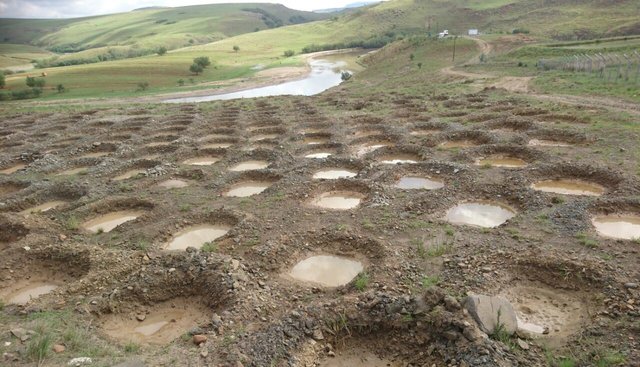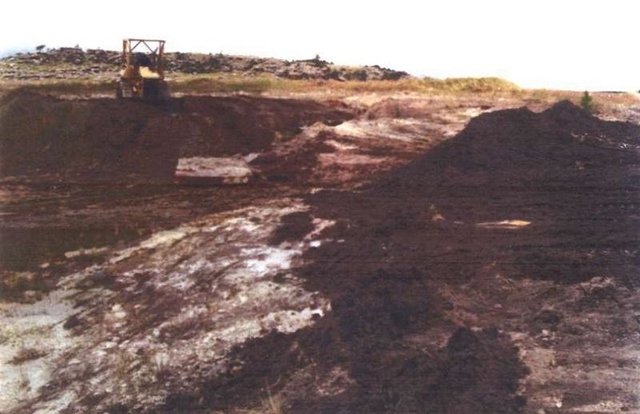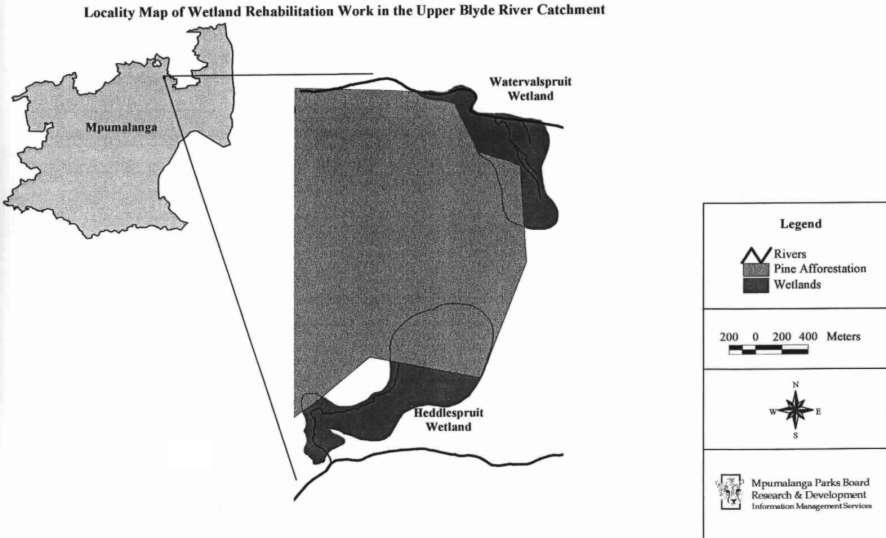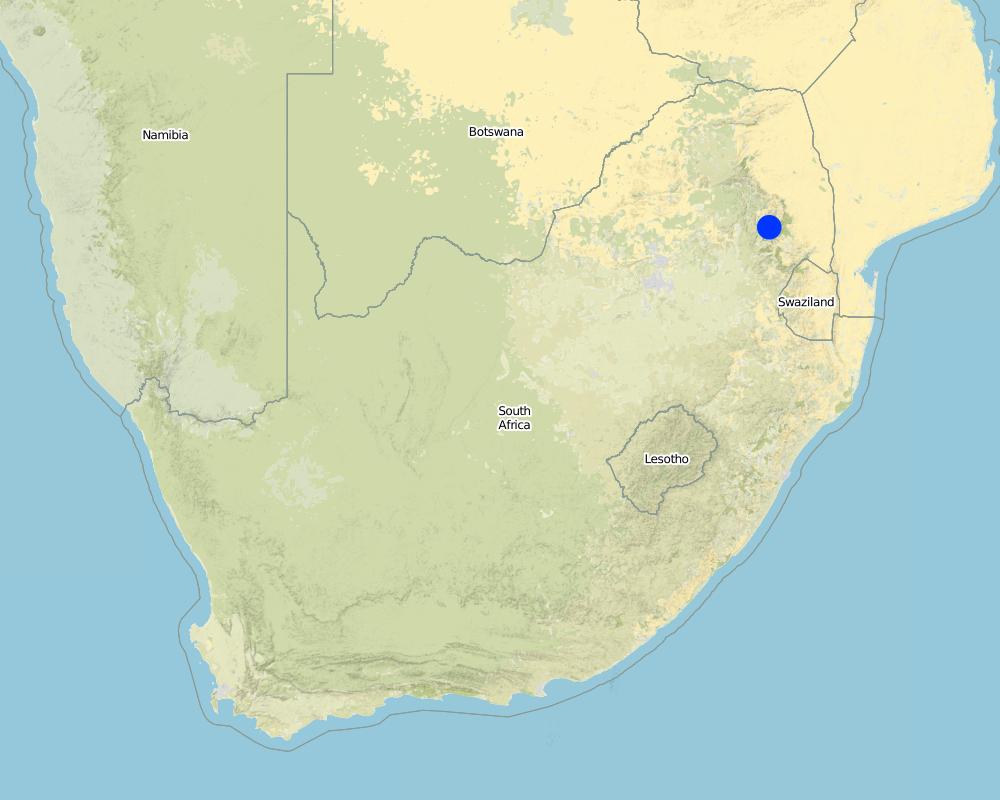Working for Water Wetland rehabilitation [แอฟริกาใต้]
- ผู้สร้างสรรค์:
- การอัพเดท:
- ผู้รวบรวม: Unknown User
- ผู้เรียบเรียง: –
- ผู้ตรวจสอบ: Fabian Ottiger
approaches_2414 - แอฟริกาใต้
ดูส่วนย่อย
ขยายทั้งหมด ย่อทั้งหมด1. ข้อมูลทั่วไป
1.2 รายละเอียดที่ติดต่อได้ของผู้รวบรวมและองค์กรที่เกี่ยวข้องในการประเมินและการจัดเตรียมทำเอกสารของแนวทาง
วิทยากรหลัก
ผู้เชี่ยวชาญ SLM:
Bronkhorst Frik
แอฟริกาใต้
ผู้เชี่ยวชาญ SLM:
Landström Anton
013 23 52 395
Mpumalanga Parks Board, P.O. Box 4442, Lyndenburg 1120,
แอฟริกาใต้
1.3 เงื่อนไขที่เกี่ยวข้องกับการใช้ข้อมูลที่ได้บันทึกไว้ผ่านทาง WOCAT
ผู้รวบรวมและวิทยากรหลักยอมรับเงื่อนไขเกี่ยวกับการใช้ข้อมูลที่ถูกบันทึกผ่านทาง WOCAT:
ใช่
1.4 การอ้างอิงถึงแบบสอบถามเรื่องเทคโนโลยี SLM

Pitting to restore degraded catchment of Mount Fletcher … [แอฟริกาใต้]
To improve infiltration and vegetation cover, by creating small pits on bare soil, which capture runoff and reduce erosion.
- ผู้รวบรวม: Dirk Pretorius

Wetland rehabilitation [แอฟริกาใต้]
To rehabilitate/stabilise distorted wetlands as close as possible to its original state/function.
- ผู้รวบรวม: Unknown User
2. คำอธิบายของแนวทาง SLM
2.1 การอธิบายแบบสั้น ๆ ของแนวทาง
To improve the quality & quantity of water production and biodiversity in the Blyde River catchment area.
2.2 การอธิบายอย่างละเอียดของแนวทาง
การอธิบายอย่างละเอียดของแนวทาง:
Aims / objectives: Stabilise, landscape and re-vegetate degraded wetlands in the upper Blyde River catchment. The objective was to re-instate the previous water table and vegetation by slowing down run-off through the building of gabions, landfills, reshaping and hydroseeding. Participants: Government funding
2.3 รูปภาพของแนวทาง
2.5 ประเทศ ภูมิภาค หรือสถานที่ตั้งที่ได้นำแนวทางไปใช้
ประเทศ:
แอฟริกาใต้
ภูมิภาค/รัฐ/จังหวัด: :
Mpumalanga
Map
×2.6 วันที่เริ่มต้นและสิ้นสุดของแนวทาง
ระบุปีที่เริ่ม:
1999
2.7 ประเภทของแนวทาง
- ใช้โครงงานหรือแผนงานเป็นฐาน
2.8 เป้าหมายหรือวัตถุประสงค์หลักของแนวทาง
The Approach focused mainly on SLM with other activities (Catchment management)
To rehabilitate degraded wetlands in the upper Blyde Rive catchment area To employ jobless people in adjacent local community
The SLM Approach addressed the following problems: Stopping head-cut erosion, landscape old mine trenches, re-vegetate area of bare soil, re-visit burning programme
2.9 เงื่อนไขที่เอื้ออำนวยหรือเป็นอุปสรรคต่อการนำเทคโนโลยีภายใต้แนวทางนี้ไปปฏิบัติใช้
บรรทัดฐานและค่านิยมทางสังคม วัฒนธรรม ศาสนา
- เป็นอุปสรรค
Ignorance of forestry, mining & local communities about the importance of these natural systems
Treatment through the SLM Approach: Capacity building & extension work
การมีไว้ให้หรือการเข้าถึงแหล่งการเงินและบริการ
- เป็นอุปสรรค
Rehabilitation is an 'extra' workload. Current budget does not allow for this
Treatment through the SLM Approach: External funding: Working for Water, Landcare
กรอบแนวทางในการดำเนินการด้านกฎหมาย (การถือครองที่ดิน สิทธิในการใช้ที่ดินและน้ำ)
- เอื้ออำนวย
The existing land ownership, land use rights / water rights greatly helped the approach implementation: Both sites where work has been done is on conservation land
- เป็นอุปสรรค
Powerless to address illegal activities
Treatment through the SLM Approach: Inadequate policing
ความรู้เกี่ยวกับ SLM การเข้าถึงการสนับสนุนด้านเทคนิค
- เป็นอุปสรรค
Not much is known on rehabilitation in this veld type
Treatment through the SLM Approach: Use this as an opportunity to build up information
3. การมีส่วนร่วมและบทบาทของผู้มีส่วนได้ส่วนเสียที่เกี่ยวข้อง
3.1 ผู้มีส่วนได้ส่วนเสียที่เกี่ยวข้องในแนวทางนี้และบทบาท
- ผู้ใช้ที่ดินระดับท้องถิ่นหรือชุมชนระดับท้องถิ่น
Specific ethnic groups: Previously disadvantage communities
Specialist in this field are mainly men
- ผู้เชี่ยวชาญ SLM หรือที่ปรึกษาการเกษตร
- รัฐบาลแห่งชาติ (ผู้วางแผน ผู้ทำการตัดสินใจ)
Several government departments; working for water
ถ้ามีผู้มีส่วนได้ส่วนเสียหลายคนที่เกี่ยวข้องให้ระบุหน่วยงานตัวแทน:
Frik Bronkhorst, Anton Linström (Business plan, layout of rehabilitation work), Peter Steyn (landscaping, employment)
3.2 การเกี่ยวข้องของผู้ใช้ที่ดินระดับท้องถิ่นหรือชุมชนระดับท้องถิ่นในช่วงต่างๆของแนวทาง
| ความเกี่ยวข้องของผู้ใช้ที่ดินระดับท้องถิ่นหรือชุมชนระดับท้องถิ่น | ระบุผู้ที่มีส่วนเกี่ยวข้องและอธิบายกิจกรรม | |
|---|---|---|
| การริเริ่มหรือการจูงใจ | ไม่มี | survey; Wetland condition survey identified these two wetlands as priorities for rehabilitation work |
| การวางแผน | ไม่มี | consultation; Inputs of various specialists were used to draw up a business plan |
| การดำเนินการ | จ่ายเงินหรือสนับสนุนจากภายนอก | Contractor, casual labour; Landscaping contractor was employed to implement business plan |
| การติดตามตรวจสอบหรือการประเมินผล | ไม่ลงมือ | reporting, measurements/observations; Fixed point photography & vegetation transects, water quality tests. Report is available |
| Research | ไม่มี |
3.4 การตัดสินใจเลือกใช้เทคโนโลยี SLM
ระบุผู้ที่ทำการตัดสินใจเลือกเทคโนโลยีมากกว่าหนึ่งวิธีไปปฏิบัติใช้:
- ผู้ใช้ที่ดินเป็นผู้ตัดสินใจหลัก โดยการสนับสนุนจากผู้เชี่ยวชาญ SLM
การอธิบาย:
consultative. Also land user driven Land-users (Mpumalanga Parks Board with advice from Frik Bronkhorst). Men make decisions, no women in the specific posts.
Decisions on the method of implementing the SLM Technology were made by mainly by land users supported by SLM specialists. consultative. Also land user driven
4. การสนับสนุนด้านเทคนิค การสร้างขีดความสามารถ และการจัดการด้านความรู้
4.1 การสร้างขีดความสามารถ / การอบรม
ได้มีการจัดอบรมให้แก่ผู้ใช้ที่ดินหรือผู้มีส่วนได้ส่วนเสียคนอื่น ๆ หรือไม่:
ใช่
- SWC specialists
รูปแบบการอบรม:
- กำลังดำเนินการ
- ใช้พื้นที่ทำการสาธิต
หัวข้อที่พูด:
Rehabilitation and importance of the wetland ecosystem in water management
4.2 การบริการให้คำแนะนำ
ผู้ใช้ที่ดินมีการเข้าถึงการรับบริการให้คำปรึกษาหรือไม่:
ใช่
ระบุว่ามีบริการให้คำปรึกษาหรือไม่:
- ที่ศูนย์ถาวร
การอธิบาย/แสดงความคิดเห็น:
Name of method used for advisory service: Mpumalanga Wetland Project, Mpumalanga Parks Board; Key elements: Capacity building among land users, Wetland conservation, Wetland rehabilitation; 1) Advisory service was carried out through: government's existing extension system. Extension staff: mainly government employees 2) Target groups for extension: land user
Advisory service is quite adequate to ensure the continuation of land conservation activities; Got the expertise and gained much from this activity to contribute
4.3 การเสริมความแข็งแกร่งให้กับสถาบัน (การพัฒนาองค์กร)
สถาบันได้รับการจัดตั้งขึ้นมาหรือเสริมความแข็งแกร่งโดยแนวทางนี้หรือไม่:
- ใช่ เล็กน้อย
ระบุระดับของสถาบันที่ได้รับการเสริมความแข็งแกร่งหรือจัดตั้งขึ้นมา:
- ท้องถิ่น
ระบุประเภทของการให้ความช่วยเหลือสนับสนุน:
- การสร้างขีดความสามารถ / การอบรม
4.4 การติดตามตรวจสอบและประเมินผล
การติดตามตรวจสอบและประเมินผลเป็นส่วนหนึ่งของแนวทางหรือไม่:
ใช่
ความคิดเห็น:
bio-physical aspects were regular monitored through measurements
technical aspects were regular monitored through measurements
There were no changes in the Approach as a result of monitoring and evaluation
4.5 การวิจัย
การวิจัยเป็นส่วนหนึ่งของแนวทางหรือไม่:
ใช่
ระบุหัวข้อเรื่อง:
- นิเวศวิทยา
ให้ข้อมูลเพิ่มเติมและให้ระบุผู้ทำการวิจัย:
Vegetation transects to monitor dynamics, fixed point photographs, water quality tests
Research was carried out both on station and on-farm
5. การสนับสนุนด้านการเงินและวัสดุอุปกรณ์
5.1 ระบุงบประมาณประจำปีสำหรับแนวทาง SLM นี้
ถ้าหากว่างบประมาณประจำปีไม่เป็นที่ทราบแน่นอน ให้ระบุช่วงลงไป:
- 10,000-100,000
แสดงความคิดเห็น (แหล่งของการระดมทุน ผู้บริจาคคนสำคัญ):
Approach costs were met by the following donors: government (national): 100.0%
5.2 การสนับสนุนด้านการเงิน / วัสดุอุปกรณ์ให้แก่ผู้ใช้ที่ดิน
ผู้ใช้ที่ดินได้รับการสนับสนุนด้านการเงิน / วัสดุอุปกรณ์ไปปฏิบัติใช้เทคโนโลยีหรือไม่:
ไม่ใช่
5.3 เงินสนับสนุนสำหรับปัจจัยนำเข้า (รวมถึงแรงงาน)
ถ้าแรงงานโดยผู้ใช้ที่ดินเป็นปัจจัยนำเข้าที่มีอยู่มากมาย ระบุด้วยว่าเนื่องจาก:
- สมัครใจ
ความคิดเห็น:
Parks Board officials/advisory, supervision & monitoring
5.4 เครดิต
มีการจัดหาเครดิตมาให้ภายใต้แนวทาง SLM หรือไม่:
ไม่ใช่
6. การวิเคราะห์ผลกระทบและการสรุป
6.1 ผลกระทบของแนวทาง
ช่วยให้ผู้ใช้ที่ดินนำเอาเทคโนโลยี SLMไปใช้และบำรุงรักษาสภาพไว้ได้หรือไม่:
- ไม่ใช่
- ใช่ เล็กน้อย
- ใช่ ปานกลาง
- ใช่ อย่างมาก
Too early to comment Project has only just finished
6.3 ความยั่งยืนของกิจกรรมของแนวทาง
ผู้ใช้ที่ดินสามารถทำให้สิ่งต่างๆ ที่ได้ปฏิบัติใช้โดยแนวทางนี้ยั่งยืนได้หรือไม่ (โดยไม่มีการสนับสนุนจากภายนอก):
- ใช่
6.4 จุดแข็งและข้อได้เปรียบของแนวทาง
| จุดแข็ง / ข้อได้เปรียบของแนวทางในทัศนคติของผู้รวบรวมหรือวิทยากรหลัก |
|---|
| Job creation (How to sustain/ enhance this strength: Governmental funding) |
| Working for water principle (How to sustain/ enhance this strength: Governmental funding) |
| Opportunity to be exposed to the practical side of wetland rehabilitation (How to sustain/ enhance this strength: Rehabilitation of others wetlands and monitoring the present situation) |
| Contribute towards the natural hydrological regime of the catchment (How to sustain/ enhance this strength: Monitoring) |
| Opportunity for land users to combine ideas and to improve relationships (How to sustain/ enhance this strength: Work towards a better environment) |
6.5 จุดอ่อน / ข้อเสียเปรียบของแนวทางและวิธีในการแก้ไข
| จุดอ่อน / ข้อเสียเปรียบในทัศนคติของผู้รวบรวมหรือวิทยากรหลัก | สามารถแก้ไขปัญหาได้อย่างไร |
|---|---|
| No action from a steering committee | Get steering committee up and going |
| Lack of practical experiences on wetland rehabilitation | Get more experiences |
7. การอ้างอิงและการเชื่อมต่อ
7.1 วิธีการหรือแหล่งข้อมูล
- ไปเยี่ยมชมภาคสนาม การสำรวจพื้นที่ภาคสนาม
- การสัมภาษณ์กับผู้ใช้ที่ดิน
ลิงก์และโมดูล
ขยายทั้งหมด ย่อทั้งหมดลิงก์

Pitting to restore degraded catchment of Mount Fletcher … [แอฟริกาใต้]
To improve infiltration and vegetation cover, by creating small pits on bare soil, which capture runoff and reduce erosion.
- ผู้รวบรวม: Dirk Pretorius

Wetland rehabilitation [แอฟริกาใต้]
To rehabilitate/stabilise distorted wetlands as close as possible to its original state/function.
- ผู้รวบรวม: Unknown User
โมดูล
ไม่มีโมดูล





